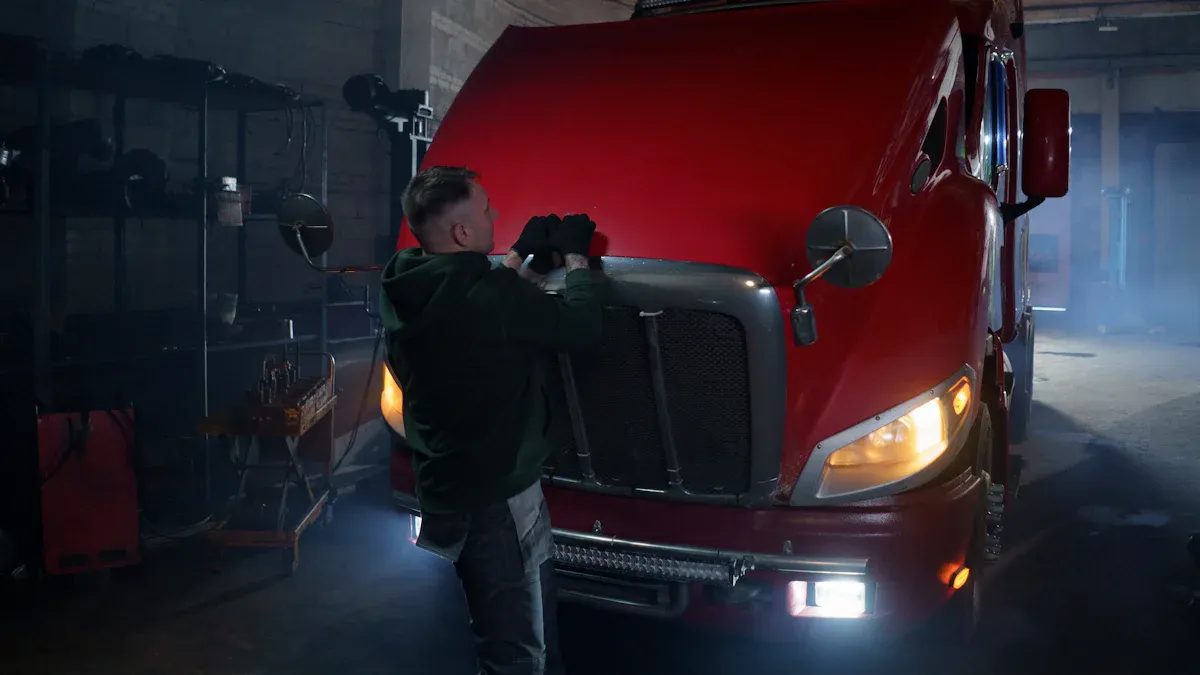Easy Ways to Keep Your Helius Headlamp Shining Bright

Keeping your Helius flashlight and headlamp clean ensures they perform at their best. Dirt and debris can dim the light, while corrosion may damage internal components. Regular cleaning prevents these issues, helping you maintain maximum brightness and extend the lifespan of your gear. A well-maintained device is always ready for your adventures.
Key Takeaways
Clean your headlamp often to keep it bright and working well. Dirt can block the light and make it harder to see outside.
Look at the battery area for rust and change bad batteries. This stops water damage and helps it last longer.
Try your headlamp before every trip. Check how bright it is, its features, and battery life to avoid problems while camping.
Why Cleaning Your Helius Flashlight and Headlamp Matters
Effects of Dirt and Debris on Brightness
Dirt and debris can significantly reduce the brightness of your flashlight. When particles accumulate on the lens, they block the light, making it appear dimmer. This can be especially problematic during outdoor activities like camping, where you rely on your headlamp for clear visibility. A dirty lens also scatters the light, reducing its focus and effectiveness. Over time, this buildup can scratch the lens, further diminishing the lumens your flashlight produces. Regular cleaning ensures your light remains bright and focused, providing the clarity you need in dark environments.
Benefits of Regular Maintenance for Longevity
Routine maintenance extends the life of your headlamp and ensures it performs reliably. Cleaning the lens keeps visibility optimal, while inspecting the device helps you catch potential issues early. For example, checking the alignment of the beam prevents glare and ensures proper direction. Inspecting the battery compartment for damage avoids moisture buildup, which can harm internal components. Regularly replacing burned-out bulbs maintains brightness and functionality. These simple steps not only preserve the durability of your camping headlamp but also enhance its features, such as adjustable settings and rechargeable options. A well-maintained headlamp remains lightweight and dependable, ready for any adventure.
Preparing to Clean Your Camping Headlamp
Turn Off the Device and Remove Batteries
Before you start cleaning your headlamp, always turn it off. This step ensures your safety and prevents accidental activation during the process. Once the device is off, carefully remove the battery. Leaving the battery inside while cleaning can lead to moisture damage or short circuits. Place the battery in a dry, safe spot to avoid misplacing it. If your headlamp uses multiple batteries, remove all of them and inspect each one for signs of corrosion or leakage. Damaged batteries can harm your headlamp, so replace them if necessary. Taking these precautions protects both you and your device.
Gather Safe Cleaning Supplies
Using the right tools for cleaning your headlamp is essential. Avoid harsh chemicals or abrasive materials that could damage the lens or casing. Instead, gather a soft microfiber cloth, a small brush with gentle bristles, and a mild soap solution. For stubborn dirt, you can use a cotton swab dipped in the soap solution to reach tight spaces. If your headlamp has metal contacts in the battery compartment, consider using a small amount of rubbing alcohol to clean them. Keep all your cleaning supplies within reach to make the process smooth and efficient. Proper tools ensure your headlamp stays in excellent condition.
Tip: Always test any cleaning solution on a small, inconspicuous area of your headlamp before applying it to the entire surface.
Step-by-Step Guide to Cleaning Your Headlamp

Cleaning the Exterior of the Headlamp
Start by wiping down the exterior of your headlamp to remove dirt and grime. Use a soft microfiber cloth to avoid scratching the surface. For stubborn spots, dampen the cloth with a mild soap solution and gently scrub the casing. Avoid soaking the headlamp, as excessive moisture can damage internal components. A small brush with soft bristles can help clean crevices and hard-to-reach areas. Keeping the exterior clean not only improves the appearance of your headlamp but also ensures its durability and weather resistance during outdoor adventures.
Polishing the Lens for Maximum Brightness
A clean lens is essential for achieving the right brightness. If your lens has minor scratches or dirt buildup, you can polish it using the following tools:
Sanding papers (start with 600-800 grit and progress to 2000-3000 grit for heavily damaged lenses).
Polishing compounds to finish the process.
Gently sand the lens in a circular motion, then apply the polishing compound to restore clarity. This process enhances the lumens output, ensuring your headlamp provides maximum light during your camping trips.
Inspecting and Cleaning the Battery Compartment
The battery compartment is a critical area to inspect during flashlight maintenance. Look for signs of corrosion, such as battery leakage or gunk buildup. Use a cotton swab dipped in a vinegar-water solution to clean the area. For metal contacts, apply a small amount of isopropyl alcohol and wipe them with a microfiber cloth. This step prevents damage and ensures long battery life for your headlamp. Regular cleaning of the battery compartment also helps maintain the best overall headlamp performance.
Removing Corrosion and Preventing Future Damage
Corrosion can compromise your headlamp's functionality. To remove it, use isopropyl alcohol and a cotton swab to clean the affected areas. Afterward, wipe the compartment with a microfiber cloth to remove any residue. For stubborn debris, compressed gas can help clear out remaining particles. To prevent future corrosion, store your headlamp in a dry place and avoid leaving batteries inside when not in use. These steps protect your headlamp's durability and ensure it remains a high-powered headlamp for all your outdoor needs.
Drying and Reassembling Your Best Camping Headlamp

Air Drying All Components
After cleaning your headlamp, drying it thoroughly is essential to prevent moisture damage. Start by gently patting all components with a dry microfiber cloth to remove excess water. Then, allow the parts to air dry in a well-ventilated area. Avoid direct sunlight, as it can warp plastic components or damage the lens.
For faster drying, you can use a hairdryer on a low heat setting. Direct the warm air into the vent or across the exterior of the headlamp to ensure all moisture evaporates. Another effective method involves placing silica gel packs inside the assembly. These packs absorb any remaining humidity, keeping the internal components dry. Proper drying techniques protect your headlamp's durability and ensure it remains a reliable tool for your camping adventures.
Tip: Always double-check that every part is completely dry before reassembling to avoid trapping moisture inside.
Properly Aligning Parts During Reassembly
Reassembling your headlamp correctly is crucial for optimal performance. Begin by inspecting each component to ensure it is clean and undamaged. Align the lens, casing, and other parts carefully, following the manufacturer's instructions. Misaligned parts can affect the beam's focus or compromise the headlamp's weather resistance.
When reinserting the battery, check the polarity markings to ensure proper placement. A secure battery connection is vital for maintaining long battery life and consistent performance. Once all parts are in place, tighten any screws or fasteners gently to avoid over-tightening, which could crack the casing. A well-assembled headlamp not only enhances durability but also ensures it remains a high-powered headlamp for your outdoor needs.
Note: If you notice any issues during reassembly, such as loose parts or misaligned components, address them immediately to avoid future problems.
Testing Your Headlamp for Optimal Performance
Checking Brightness and Light Output
Testing the brightness of your headlamp ensures it delivers the light you need for outdoor activities. Start by turning on the flashlight in a dark environment. Observe how well it illuminates the area. A high-quality camping headlamp should provide consistent light without flickering.
Key indicators of optimal brightness and light output include:
Lumens: This measures the total brightness of your headlamp. Higher lumens mean brighter light.
Peak Beam Intensity: Measured in candela, this shows the maximum intensity of the beam along its central axis.
Beam Distance: This indicates how far the light travels before it dims to the brightness of moonlight.
If your headlamp fails to meet these standards, consider cleaning the lens again or replacing the battery. Testing and maintaining your headlamp regularly ensures it remains reliable for camping and other adventures.
Tip: Use your headlamp's adjustable settings to test different brightness levels and beam distances. This helps you find the best configuration for your needs.
Ensuring All Features Are Functional
After checking brightness, test all the features of your headlamp. Activate the adjustable modes, such as dimming or strobe functions, to confirm they work correctly. If your headlamp is rechargeable, plug it in and ensure the charging indicator lights up. For camping headlamps with waterproof or weather-resistant features, inspect the seals and casing for damage.
Lightweight headlamps often include advanced features like motion sensors or red-light modes. Test these to ensure they respond as expected. If any feature malfunctions, refer to the user manual for troubleshooting tips. Regular testing and maintaining your headlamp keeps it in top condition, extending its life and enhancing its durability.
Note: Always test your headlamp before heading out on a camping trip. This ensures you won’t face unexpected issues in the field.
Maintaining your Helius headlamp ensures it stays bright and reliable for every adventure. Regular cleaning and inspections prevent dirt buildup, corrosion, and performance issues. Proactive care offers several long-term benefits:
Prevention of light output reduction, which can drop by up to 80% with cloudy lenses.
Early detection of potential problems, avoiding complete failure.
Incorporate these steps into your routine to extend your headlamp’s lifespan and enjoy consistent performance. A well-maintained headlamp keeps you prepared for any challenge.
FAQ
How often should you clean your Helius headlamp?
Clean your headlamp after every outdoor trip. Regular cleaning prevents dirt buildup and ensures optimal performance. For frequent users, a monthly deep clean is ideal.
Tip: Always inspect your headlamp before storing it to catch any dirt or damage early.
Can you use any cleaning solution on the lens?
No, avoid harsh chemicals. Use a mild soap solution or lens-safe cleaner. Harsh substances can damage the lens coating and reduce brightness.
Note: Test the cleaner on a small area first to ensure compatibility.
What should you do if your headlamp stops working?
Check the battery compartment for corrosion or loose connections. Replace the batteries if needed. If the issue persists, consult the user manual or contact customer support.
Emoji Reminder: 🔋 Always carry spare batteries during outdoor adventures!
See Also
Helius Tactical Flashlight: Lighting Up Your Journeys
In-Depth Review of Helius W644 Rechargeable Spotlight Headlamp
HeliusWorld Flashlights: Brightening Your Outdoor Experiences
Explore the Helius Lantern Flashlight with 200-Hour Battery Life
